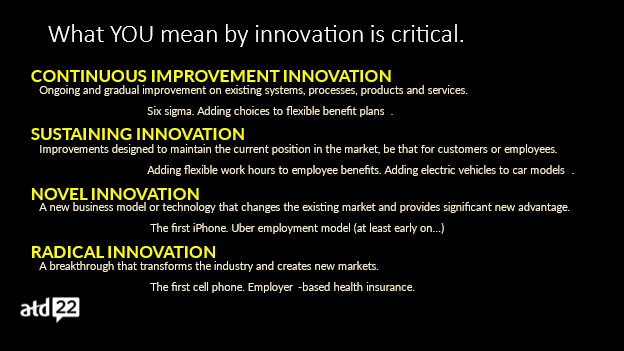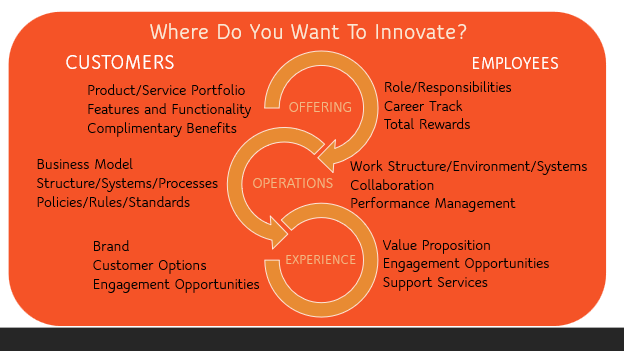ATD Blog
Drive a Culture of Innovation
Mon Jan 09 2023

From setting goals to breaking down barriers, TD is critical to helping leaders and employees break the status quo.
Disruption. It doesn’t sound like something positive, but it actually has two positive purposes. The first is to bring an end to a system, process, or practice that is inadequate (that is, not producing the desired result) or wrong (unfair, immoral, dangerous, discriminatory). The second is expressly to innovate. Clayton Christensen, Harvard Business School professor and author of The Innovator’s Dilemma, calls that disruptive innovation.
Arguably, the difference between innovation and disruptive innovation is murky and a matter of degree—so is the distinction between improvement and innovation.
We could regard disruption and innovation as more extreme versions of the same change process the talent development function has been supporting for decades. That means breaking the status quo and creating and implementing a better alternative.
To do that, we must adopt four critical attributes of innovation as the hallmarks of our talent development work. Innovation must be:
Intentional. It must be a part of the culture and reflected in the organization’s values. It must be a proactive element of how everyone works.
Organization-wide. It should be pervasive, at every level in every discipline.
Radical. Incremental improvements should always be a part of how companies evolve, but disruption and innovation aim at giant leaps; radical changes; and whole new products, services, and markets. Revolutionary change is the goal.
Continuous. Rather than a string of discrete interventions, innovation must be the ongoing way employers conduct business. Constant dissatisfaction with the status quo is built into systems and processes, rewards and recognition, and the criteria for success for the organization and its employees. The focus never ends.
The Five Levers of Innovation
This is the first article in a five-part series by ATD’s CTDO Next consortium of top talent development leaders who are shaping the future of the profession. This series explores the levers of innovation, or the places where talent development can lead. The five innovation levers include:
Creating a culture of innovation
Fostering an innovation mindset among leadership
Building innovation capability
Empowering teams to innovate
Optimizing systems and processes for innovation
Leading the organization to create and sustain a culture of innovation is fundamental. Without it, every other effort is diminished.
A culture where innovation can flourish is open, diverse, self-aware, and safe. It provides an environment where trial and error is encouraged and learning from mistakes is accepted and even celebrated. Helping individuals understand those elements and adopt the necessary practices is clearly in L&D’s wheelhouse, and aligning talent development and coaching to the policies and practices that support an innovative culture is critical for success.
Define Innovation
To reinforce innovation as a critical aspect of the culture, determine what innovation means to your company. Here’s a simple breakdown that can act as a guide:

In practice, not every part of the organization is likely to be dedicated to radical innovation, nor does it need to. However, some should. Too many organizations make innovation a stated value without ever gaining consensus on what that means.
One way to think through where to focus the organization’s innovation efforts is to explore the offering, operations, and experience (see below). For each area you identify, determine the reason.

The thought process associated with those two breakdowns will go a long way in helping you establish how critical innovation is to the company’s purpose. Whether the primary drivers are customer loyalty, growth, operational excellence, speed to market, employee loyalty, or a host of other missions, you can help the organization understand innovation as a strategic imperative.
Develop an Innovation Strategy
To create a strategy, start with conducting a culture audit. That defines where the culture supports or even demands innovation as well as aspects that are lacking.
Next, work with leadership to determine the strategy that will close the gap between the current culture and the innovation culture you desire. That may mean collaborating with top leadership or gathering an innovation culture steering committee to provide greater visibility and focus on the changes you want to make.
Set Innovation Goals
Even without a steering committee, you can translate the audit results into innovation goals. Examples of those at the broadest business level are:
Ten percent of next fiscal year revenue will be from new products and services.
Fifteen percent of new customer acquisition will be in new markets.
Top customers will rate us as their most innovative business partner.
Goals can also be specific to functions, geographies, and departments. Such as “Develop three new customer driven products each year,” or “Cut new employee time to full productivity in half.”
Goals can even focus directly on innovation projects:
Number of projects
Diversity or project teams
Number of new ideas generated
Number of new ideas implemented
Time from idea generation to implementation
Revenue from new ideas
Action learning programs can be a great methodology that you can use to establish and pursue innovation goals. And the movement from culture to strategy to goals can solidify the culture of innovation.
Cultivate Key Cultural Values
Even when you use technology to innovate, you’ll need collaboration from many areas of the organization to achieve success. Innovation is a collaborative process, where people in many fields with diverse experiences and points of view contribute.
Work with leadership to create a transparent environment, one in which employees have unfiltered access to massive amounts of information about the business, its performance, leaders’ activities, and the organization’s future. This should be an environment in which anyone can quickly find information about company culture and employee attitudes.
In our areas of expertise in TD, we can design the systems through which employees can find information about jobs, salary ranges, roles, necessary skills, career paths, and company-provided development options. If development options are not available to everyone, staff will know it.
Financial services company HSBC recently launched the Talent Marketplace using GLOAT technology. That matches employee skills or desired development areas to projects, open roles, and networking opportunities. It helps with transparency and career pathing and aims open more opportunities to more people.
The workplace is already much different than the landscape talent development professionals may be used to. The when and where of all types of talent development have already changed to always and everywhere.
Going forward, who we develop, how we develop them, and what capabilities we strive to develop in them will change dramatically. All of talent development will be democratized.
Development will not be a program or curricula aimed at selected individuals or groups. It will be a wide array of services and resources made available for everyone inside and even outside the organization.
Break Down Barriers
The most cited cultural barriers to innovation are a lack of leadership support, a failure to engage all employees, and a contradictory performance management system. All of these are within our power to significantly influence.
HSBC has a forum called “Dragons Den,” where employees submit business cases and innovative ideas to that senior leadership team. Not only does this open the door for new ideas, it is also a great talent development opportunity through which individuals gain exposure to senior leaders and build their network.
TD can help our organizations to re-evaluate and redesign how performance management works, beginning with managers. If their evaluation emphasizes the value of innovation as much as the traditional bottom-line measures, that will translate to the teams they manage.
Performance reviews can include looking at how learning and innovation are encouraged and rewarded by people managers and, most importantly, at how risk and failure are reflected in the review process. Do they encourage employees to think innovatively and reward them for bringing forward new ideas, being curious, and taking the time to learn.
The right reward system goes a long way to engage all employees, but we can also build the systems and tools that enable and encourage everyone to be innovators. We can establish processes through which everyone is encouraged to speak out and is rewarded for doing so.
Measure How Culture Supports Innovation
Creativity and innovation can be tough to measure, but some of the input and outputs can give a solid indication of the how the culture fosters them. Input measures are easier, such as how much people are learning, who’s training in innovation methodologies, the number of new ideas generated and taken into production, proliferation of experiments, the number of new initiatives coming from employees versus management, and even things like budgets for innovation and time spent on new ideas.
Opinion measures also can be valuable. Do employees think the company is innovative? Do they think they are innovative?
The output metrics are harder. However, if you set innovation goals, they will offer clear opportunities for solid metrics. The right goals let you measure innovation around things such as revenue from new products and services, penetration of new markets, and even customer rating of your innovativeness.
In addition, you can measure beyond initial implementation of new ideas by tacking whether the innovations are taken to scale and even the cycle time for new things to become normalized in the company.
And TD can make a further contribution by teaching data visualization, making new ideas more easily understood and measured more broadly—not to mention easier to share.
For a long time, TD has been the official or unofficial caretaker of culture. But that is beginning to change as CEOs and the C-suite understand and accept their ownership.
What hasn’t changed is that TD is the part of the function that enables that ownership. We provide ongoing development that supports empowerment of individuals and teams and feeds a culture of innovation.
